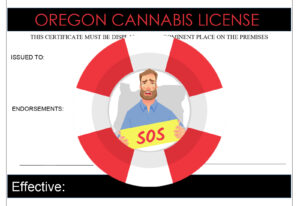
Here we are at the end of 2018, which means it’s time for the third annual “State of the State” post on Oregon cannabis (the 2017 post is here and the 2016 post is here). The year 2018 was truly remarkable in the Oregon industry, and we saw a lot of change, from regulatory evolution to industry consolidation to overall market dynamism. Below is a high-level summary of what we are seeing in the industry as we move into the new year.
Competition is intense.
The marijuana market is saturated with both licensees and product. October is always the peak month for harvest, and the Portland Business Journal, by way of OLCC, reports that producers brought in 2.54 million pounds that month (measured in wet weight). This was a slight increase from 2.48 million harvested pounds in 2017. For the full year, production was running 9% higher than 2017, and wholesale prices fell by more than 50% from mid-2017 to mid-2018. As any store owner will tell you, retail prices have fallen significantly too.
In addition to product saturation in the market, the number of licensees has continued to grow. OLCC issued an additional 300+ producer licenses in 2018, bringing the total number to 1,110. There are also 1,141 additional producers awaiting licensure. With respect to retail, there are now 606 active dispensaries in the state, including 173 of them in the City of Portland alone. Although OLCC officially “paused” its review of all new applications submitted after June 15th, we don’t see the market becoming less competitive anytime soon.
The M&A market is also intense.
There are no readily available statistics on the number of purchases and sales of marijuana businesses statewide. Anecdotally though, the amount of this activity coming through our office is remarkable. In the past 12 months, we have handled more cannabis business mergers and acquisitions than we ever could have predicted. These transactions range from people giving up failed businesses for a song, to leading local brands joining forces, to the seemingly never-ending stream of reverse mergers and acquisitions involving Canadian public companies. Although Oregon is no longer the only state to allow non-resident ownership, we don’t see a slowdown in this type of activity anytime soon. Expect Oregon to remain a buyer’s market in 2019.
The rules are pretty settled…
Oregon’s statutory changes and administrative rules didn’t change radically in 2018– at least compared to the past few years. OLCC continues to work around the edges, as with the recent push to end the alternating proprietor arrangement and to tighten up the definition on banned “added substances” in finished products. Overall, though, much of the legislative and agency efforts were centered on black market eradication and on building out the industrial hemp program. We applaud both of those efforts.
… But people keep stepping in it.
If the leading 2018 activity for our Portland marijuana business lawyers was buying and selling businesses, dealing with administrative violations was a close second. OLCC has stepped up its efforts program-wide in this manner: It begins with application scrutiny and extends through notices of violation against licensed operators. Certain violations are unfortunately common. Those include “financial interest” violations (yes, lenders must be disclosed), unapproved site changes, camera issues and manifest issues. We are seeing the same types of things, over and over, from companies large and small. Although many of these matters can be settled, they require extreme care and attention, and are best avoided through vigilant compliance.
People are suing each other.
We mentioned litigation last year, and this year is no different. Some of these disputes stem from business failure, undocumented transactions or deals gone south. We still come across the odd con job. There are also more exotic matters like RICO lawsuits and nuisance battles between marijuana and hemp farms. As long as the industry continues to evolve at its current rapid pace, we expect to see more litigation than in other commodities markets.
Hemp just keeps getting bigger.
This has been another big practice area for our office. Industrial hemp demand skyrocketed in 2018 with the CBD craze. Many Oregon farms and processors capitalized, with the number of Oregon Department of Agriculture (ODA) growers rapidly expanding from 233 to 568. As compared to OLCC licensing, acquiring a hemp grower’s or handler’s registration from the ODA is fast and easy, and restrictions on sale are far less cumbersome. Now that hemp is legal nationwide, we only expect this trend to continue into 2019.























